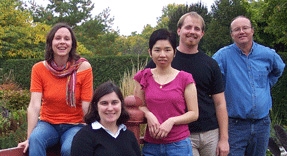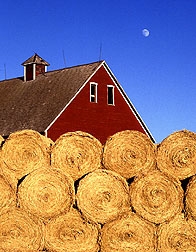 |
| Amy Charkowski, seated, and students |
Amy Charkowski works on the front lines of protecting Earth's food supply. She does basic research in locating mechanisms that cause viral and bacterial diseases in potatoes. She also works on the detection of pathogens and pays attention to what diseases are coming into the U.S. from other countries. She is an Assistant Professor of Plant Pathology at University of Wisconsin, Madison. Earth & Sky's Abby Frank spoke to her in 2005.
Frank: Your focus on microbes in your work. What are they and why are they important?
Charkowski: Bacteria and fungi and archaea and viruses: they're the most abundant types of life on Earth. They're everywhere. They're on us, inside us. They're on leaves, on roots, in the soil. And they're important for all sorts of processes. They're required to keep life going on the planet. Basically, they recycle everything.
So one of our interests is microbial diversity. How do we find out what's out there, and what they're doing? We're specifically interested in the diversity in pathogens.
In the past, even just in the past decade, we've had a huge increase in the amount of travel, both in people and in agricultural products. So we have a lot of fruits and vegetables and plants traveling around the world in ways that they weren't before. You can see that in the grocery store. You go there, and you'll see grapes from Chile and maybe cantaloupes from Guatemala. In the spring, we all go out and buy plants for our gardens, and those plants might have started in Kenya. They might have started somewhere in Central America. They were propagated there and brought into the U.S.
All of those fruits and vegetables and ornamental plants are bringing their microbes with them. Some of those are pathogens and when they come into the country, often times nothing serious happens. But when they find themselves in a new environment, sometimes you have really serious problems.
We're stirring up the system by transporting things around the world. We've really changed our environment. Someone who lived 100 years ago might not recognize certain things anymore.
 |
| (USDA-ARS K7862-1 / Scott Bauer) |
Frank: How does the study of microbes relate to our global food supply?
Charkowski: Microbial diseases are one of the main constraints in food production, particularly in tropical countries. When a plant gets sick, you don't usually cure it. We try to control disease by preventing it.
It affects where we grow things. In the U.S., for example, we grow potatoes in the northern states for the most part and not in the south because the pathogen pressure is so much higher in the southern U.S. The U.S. is a large, wealthy country. So we can grow specific types of crops in specific regions where the pathogens for that particular crop are not as bad. That's pretty much why we grow certain things in certain regions.
It's changed over the years what we grow where. For example, we used to grow a lot of barley in Wisconsin, which is why Milwaukee was a big beer area. Because of disease pressure it became less economical to grow it here in Wisconsin. All of that type of agriculture moved west.
In other countries that tend not to be as wealthy, it's more of an issue of life and death. You can get famines caused by pathogens.
Frank: So what do we do?
Charkowski: I think the most important and economical way to deal with food pathogens is through plant breeding, and by trying to develop resistant varieties. You don't need pesticides to control the plant diseases if the plant has some resistance to the disease.
But it's never a job that you can finish, because plant breeders will breed for resistance to a virus or whatever microbe or bacterial pathogen or fungal pathogen. And then usually the pathogen overcomes that resistance. So it's something that has to keep going and going.
One of my colleagues, who runs a large research institute in the tropics, was talking about how difficult it can be to get funding for this type of work. For example, I think it was a banker that said to her , "Why aren't you done yet? You've been doing this for 40 years. Why don't you have the resistant plants yet?" She was trying to explain that you never actually get done with it. You find something that's useful for maybe a decade or two and then you have to keep working at it.
And then the other thing that we can do is try to work as hard as possible to keep new diseases from spreading. There are a lot of diseases that aren't yet, for example, in South America, that aren't yet in Asia, or not yet in Africa, or not yet in North America. We would like to keep those pathogens out from whatever location you're talking about. So that's, for example, one of the reasons why they, when you coming in from another country, they ask if you have fruits or vegetables, to try and keep those pathogens out. When something comes into a country, it's often screened, at least at some level, for diseases to try and keep them out of the local agriculture. But it always feels a little bit like a losing battle, I think.
There's so much trade in agricultural products that it's a needle in the haystack problem. Say you have 14 million plants coming in from another country and you have a disease incidence of 0.1 percent. How do you determine if it's there or not? It's a huge problem in how to detect the disease or the pathogen.
It also feels a little bit, sometimes, like a hard battle with breeding because the microbes are always out there trying to overcome the resistance and there are new ones evolving regularly — not new microbes, new pathogens necessarily evolving, but new strains that pop up quite regularly. So something that was resistant last year might not be resistant this year.
Frank: Are humans a threat to our own food supply?
Charkowski: I think when you think about trade, yeah, we can sometimes be a threat to our own food supply — by bringing microbes where they didn't use to be. There've been plenty of examples of that. There're a lot of historical examples that I think a lot of people are aware of, like the Irish potato famine. That was a pathogen that came into Ireland that wasn't there before and caused havoc. There have been lots of examples like that in history.
Frank: Organic agriculture has been gaining popularity in the U.S. Can we produce enough food to feed the world without machines and fertilizer?
Charkowski: It's a debate right now and I don't think we have all of the information because there are two ways of looking at it. One is sustainable — sort of fewer inputs and more organic agriculture. Right now the methods we have for that require more land. So then the other alternative is to try to use less land but use it really intensively. And maybe that would have less of an impact on our environment. I think it's a really complicated question that's going to go crop by crop. I don't think we have the answers to that yet.
The crops that I work with are pretty intensive — there are not a lot of organically grown potatoes out there, for example. And they do use a lot of inputs and a lot of big machines and that kind of thing. I don't know that that's going to change in the near future.
Frank: Are you optimistic about the future of our food supply?
Charkowski: I think I'm generally an optimistic person, but there are so many things that go into that. There's political issues that affect it and energy issues, because you were asking about the large equipment and the fertilizers and a lot of that requires oil. And then the disease issues. I think we'll find ways to feed ourselves. It's hard to know what agriculture is going to look like in 100 years. I'm less optimistic about what our natural environment's going to look like because of new pathogens that we're mixing around the world. The natural world, the type of trees we have in our forests, for example, are quite different from when my grandfather was a child compared to what it is going to be like when my daughter grows up. It's changed a lot in the last century because of the way microbes have traveled along with humans. That to me is a lot more depressing.
Frank: What will it take for humans to survive on Earth?
Charkowski: We need to develop an appreciation for how much we affect the world around us. I don't think we always appreciate the consequences of our actions and particularly ones that happen over like a span of decades or longer. So we need to become better at seeing the long term affects of the decisions we make. That's just going to require us to learn a lot more about — we don't know that much about microbes yet. As much as we know, we don't know most of the species that are out there. We don't really understand how they survive out in the real world, what they're doing. We can't predict the effect of introducing a new species into an environment. So we just have so much to learn. I think that's another big part of what it will take. We need to understand the system better.
Frank: Dr. Charkowski, thank you for taking the time to speak with us today.
Page created on 10/15/2011 1:18:46 PM
Last edited 1/9/2017 9:31:49 PM
